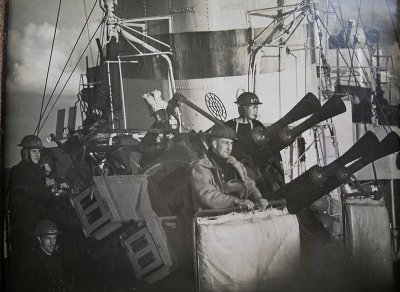![]() The Pacific War Online Encyclopedia
The Pacific War Online Encyclopedia
|
| Previous: British 16"/45 Gun | Table of Contents | Next: British 47mm/40 Gun |

| Bore |
40mm 1.57" |
| Ammunition Type |
Contact fused HE fixed shell |
| Weight of round | 1.684 lbs 0.764 kg |
| Velocity | 2400 feet per second 732 meters per second |
| Maximum elevation | 80 degrees |
| Range | 6800 yards (but see text) 6220 meters |
| Altitude |
13,000 feet 3960 meters |
| Rate of fire |
115 rounds per minute |
The 2-pounder "pom-pom" was developed during the First World War as a naval weapon for defense against both aircraft and motor torpedo boats.
Rushed into production, it proved unreliable in service, but with
postwar improvements it became the chief British naval light
antiaircraft gun, and remained so throughout the Second World War, only
gradually being replaced by Lend-Lease 40mm Bofors guns.
The gun was basically a scaled up version of the Maxim machine gun, with a toggle locked short recoil action. It was water-cooled and belt-fed with a good sustained rate of fire, further enhanced by its use in quadruple or eight-barreled mountings. The rounds were self-destroying at 2500 yards (2290m) to avoid friendly fire incidents and to distract enemy pilots with their bursts. However, the muzzle velocity compared unfavorably with the Bofors. The 2-pounder was also adopted by the British Army as a light antiaircraft gun, but the Army was faster than the Navy to replace it with the Bofors.
By the time war broke out in the Pacific, fire control was
provided by the Mk IV director, a rather elaborate tachymetric director
with gyroscopic stabilization requiring a crew of four. This was too much for quadruple mounts on destroyers, which omitted the director and relied on tracers for correcting aim.
The British were pessimistic about the effectiveness of the
pom-pom, having conducted tests in which they
concluded the gun would have just ten seconds of firing time against a dive bomber,
with no more than 5% hits. This meant about a 67% percent chance of
scoring one or more hits before the dive bomber released its bomb, which was probably wildly optimistic. However, the weapon was valued for its expected effectiveness against motor torpedo boats in the restricted waters of the Mediterranean.

|
References
Friedman (2006, 2013)
Hogg (2002)
The Pacific War Online Encyclopedia © 2007, 2009, 2013-2014 by Kent G. Budge. Index